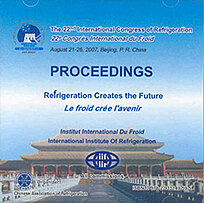
IIR document
Two and three dimensional CFD models of the effectiveness of an air curtain used to restrict cold room infiltration.
Author(s) : FOSTER A. M., SWAIN M. J., JAMES S. J.
Summary
The aim of this study was to compare the measured effectiveness of an air curtain device at different jet velocities against predictions from 2D and 3D computational fluid dynamics (CFD) models. The predicted maximum effectiveness of the air curtain was 0.13 higher than measured for the 2D model and 0.05 lower than measured for the 2D model. The 2D model under predicted the optimum jet velocity by 7.5 m/s, the 3D model over predicted it by 4 m/s. CFD has shown that the flow from this air curtain cannot be considered as 2D. The central part of the jet is deflected away from the cold store by the Coanda effect caused by the air curtain device's fan body. The edges of the jet are deflected into the cold store by the stack pressures and turn into the void caused by the deflected central jet.
Available documents
Format PDF
Pages: ICR07-D1-1238
Available
Public price
20 €
Member price*
Free
* Best rate depending on membership category (see the detailed benefits of individual and corporate memberships).
Details
- Original title: Two and three dimensional CFD models of the effectiveness of an air curtain used to restrict cold room infiltration.
- Record ID : 2008-0295
- Languages: English
- Source: ICR 2007. Refrigeration Creates the Future. Proceedings of the 22nd IIR International Congress of Refrigeration.
- Publication date: 2007/08/21
Links
See other articles from the proceedings (839)
See the conference proceedings
Indexing
- Themes: Cold stores : design, construction, insulation and equipment
- Keywords: Velocity (fluids, gases); Jet; Cold room; CFD; Air curtain; Efficiency; Air
-
Flow regimes and thermal patterns in cold rooms.
- Author(s) : ABOU ZIED A., EL-HARRIRY G., KHALIL E. E.
- Date : 2013/06/16
- Languages : English
- Source: Clima 2013. 11th REHVA World Congress and 8th International Conference on Indoor Air Quality, Ventilation and Energy Conservation in Buildings.
- Formats : PDF
View record
-
Numerical investigations into the performance o...
- Author(s) : PAPPAS T. C., TASSOU S. A.
- Date : 2003
- Languages : English
- Source: ASHRAE Transactions. 2003 Winter Meeting, Chicago, Illinois. Volume 109, part 1 + CD-ROM.
View record
-
AIR INTERCHANGE RATE THROUGH A COLD STORE OPEN ...
- Author(s) : MORENO J.
- Date : 1987/08/24
- Languages : English
- Source: Development in refrigeration, refrigeration for development. Proceedings of the XVIIth international Congress of Refrigeration.
- Formats : PDF
View record
-
ECHANGES ATMOSPHERIQUES LORS DE L'OUVERTURE D'U...
- Author(s) : AZZOUZ A., GOSSE J., DUMINIL M.
- Date : 1987/08/24
- Languages : French
- Source: Development in refrigeration, refrigeration for development. Proceedings of the XVIIth international Congress of Refrigeration.
- Formats : PDF
View record
-
Air infiltration into walk-in cold rooms throug...
- Author(s) : CLELAND D. J., EAST A. R., JEFFERY P. B.
- Date : 2015/08/16
- Languages : English
- Source: Proceedings of the 24th IIR International Congress of Refrigeration: Yokohama, Japan, August 16-22, 2015.
- Formats : PDF
View record
